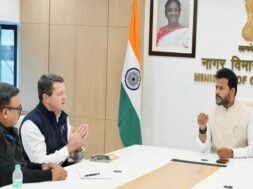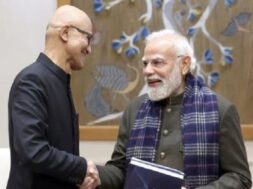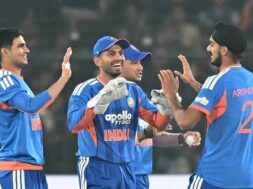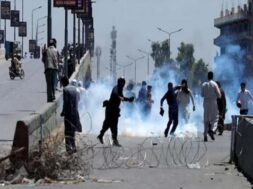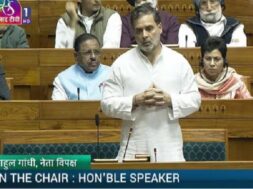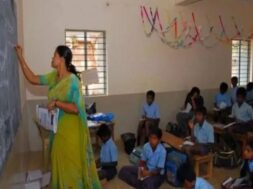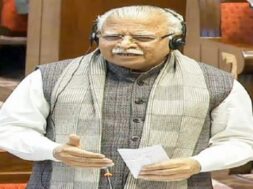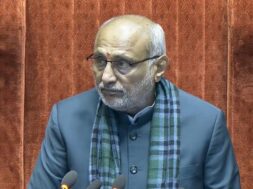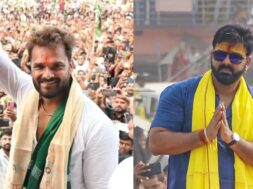
Virendra Pandit
Karnavati (Gujarat): Dispelling confusion prevailing among many people about the real meaning of the word “Dharma”, Rashtriya Swayamsevak Sangh (RSS) Joint General Secretary Dr. Manmohan Vaidya has said the word connotes manifestation of one’s spirituality in his or her social behavior.
Dharma does not discriminate. It connects and unites all. Binds all and holds them all together. Dharma enriches social capital. We should give back to society more than we take from it. Life should be meaningful, rather than successful. Dharma is like a wheel that must rotate and move, he said explaining the meaning of Dharma Chakra Pravartanay.
Delivering a thought-provoking lecture during the two-day, Madhav Smriti Nyas’ 17th Guruji Vyakhyanmala here, he said the two words—religion and secularism—have been much misunderstood in Indian because these western concepts are untranslatable in any Indian language.
He said the word Dharma has a wider meaning, unlike religion which basically narrowly means the mode of worship. Dharma is not outwardly exhibitionism. Following rituals or going to temples is not Dharma but an Upasana (mode of worship), which leads to the wider Dharma.
Dr. Vaidya explained that Dharma is inclusive of all, wherein people work for the welfare of the whole society. It is the journey from “I” to “Us”. To expand one’s circle continuously and realize the presence within of what exists without. This is moksha, or salvation, aiming at the unification of all flora and fauna. To give back to society is Dharma.
“That is why my house is a house; the one built for others is called Dharamshala. Similarly, a dharmada dispensary is for the people.”
The RSS Sah Sarkaryavah referred to the Hollywood blockbuster Avatar where a character says the Mother Tree does not take sides. Dharma also does not distinguish between the people. It celebrates variety and balance of life.
He cited the examples from the RSS volunteers’ selfless contribution to society, especially during the calamities. “The RSS volunteers currently run 130,000 service projects across India, and 15,000 schools, 90% of which go without any government grants.”
It is because of India’s ancient practice of Dharma that, despite so many assaults from without, the country lost only kingdoms, not the society. “We have survived so many vicissitudes, like a starfish, because our centers of power always remained decentralized. The makers of the Constitution were aware of the importance of Dharma in India’s social life.
“The Constituent Assembly had discussed the foreign word ‘secularism’ but not the meaning of the Bharatiya word Dharma because they were aware that it was India’s very soul. They discussed, debated, and decided that it (the word ‘secular’) should not be included in the Constitution as it was found unnecessary.”
He also referred to the inability of a law professor to reply to a student’s query during a lecture at the Indian Institute of Mass Communication (IIMC) as to why did the government introduce the 42nd Amendment in the Constitution to include the word ‘secular’ in the Preamble if the basic structure of the statute was declared unalterable.
“I never get a straight answer from anybody why they are, or they are not, secular. Dharma is not merely religion. When translated as religion, it created a lot of confusion. Dharma is Dharma. The makers of the Constitution had got it written in the Lok Sabha: Dharmachakra Pravartanay (Rotation of the Wheel of Righteousness).
Similarly, a phrase written in the Rajya Sabha says Satyam Vad, dharmam Charah. In the Supreme Court, we find Yato Dharma, Tatah Dayah. And in the Research and Analysis Wing (RAW), we find the words: Dharmo Rakshati Rakshitah. Even in the Tricolour, the chakra is Dharmachakra, also known as Ashok chakra.
In so many institutions, he said, the word Dharma is respectfully mentioned.
There must be some reason why Dharma is so deep-rooted in India. It has been a very important part of Indian life and culture. “If you want to understand Dharma, then understand Bharat first.”
India is unique in the world because of its peculiar way of life. The very basis of Indian life is spirituality. No other country can boast of spirituality as a way of life. This has shaped India’s personality, which has four aspects.
Firstly, for us, Truth is one which we call by different names and where we can reach following different and equally-important paths. Ekam Sad Viprah, Bahuda Vadanti.”
He referred to Swami Vivekanand’s enlightening speech on the equality of all faiths during the Parliament of World Religions Conference held in Chicago (USA) in 1893. Many participants there had claimed superiority of only their own faiths. Vinoba Bhave also said that a belief in salvation through this way ‘only’ is non-Hindu, and salvation through this path ‘also’ is being Hindu.
The difference between these two words, ‘only’ and ‘also’, should be understood.
About foreign religions, Dr. Vaidya said these faiths propagated that only they could comprehend the truth and it was their divine duty to make the believers reach Paradise. Towards this end, they must convert the unbelievers through force, fraud, and allurement. But they found force would not work in the long run. So they began to ‘tolerate’ others until the unbelievers converted.
But Swami Vivekanand said we should actually go beyond tolerance and accept pluralism and multiple ways to reach the truth. The Swami declared that he was proud to have come from a country whose language Sanskrit had no word like ‘exclusive’ as the Indians excluded nothing. For them, the philosophy is to include all.
Secondly, India celebrates unity in diversity and establishes unity among variety, Dr. Vaidya said, citing Nobel Laureate Rabindra Nath Tagore.
That is why India does not confuse ‘variety’ as ‘difference’, nor believes aliens are enemies. “So we would not be panicked by attacks from new human groups. We should learn from them. We have the capacity to take them all with us together. It is not correct to say that India has diverse cultures; actually, India has one culture that celebrates diversity.
Thirdly, we should know that every soul is potentially divine and the goal of human life is to manifest the divinity within by controlling nature internal and external. All humans, men, and women have equal divinity in them. The final goal of human life is to exhibit this divinity and attain moksha. Only India believes in many ways for salvation; in other countries, they cannot think of any other way but their own.
Among the Hindus, the composition of karmayoga, gyanyoga and bhaktiyga may differ from one person to another. Each one has to select this composition as per his or her desires and walk the path to salvation. That is why, religion can be different for different people, as personal as one’s toothbrush.
Fourthly, the Indians accept all paths to salvation in the same family; some believe in nirgun-nirakar, others in sagun sakaar. Each member of the family has complete freedom to select his or her own way of worship. We accommodate all god, he explained.
There has also been some confusion in the usage of the word ‘Hindutva’. Some people use alternatives like Sanatan, Indic etc, which demonstrates India’s peculiarity.
Quoting from Tagore’s Swadeshi Samaj, he said that the very concept of a welfare state is a Western tradition. That the state is supreme is itself a foreign concept. A Swadeshi Samaj is one that is self-sufficient and the least dependent on the state. Vinoba Bhave had also said that Swaraj was important only until India was under a foreign rule. “Now that we have Swaraj, it is time to awaken the Lok Shakti. A society over-dependent on the state becomes indolent and weak. The Indian society always had its own self-reliant social systems in place except in matters like defense, and external affairs.”
Referring to a book The Starfish and the Spider by Ori Brafman and Rod Beckstrom, Dr. Vaidya said the writers, who studied structures of different corporations and communities, concluded that the spider can survive without some of its legs but not when its tiny head carrying life centers is crushed; on the other hand, it difficult to kill the starfish as its life centers are spread across the entire body.
He also narrated how the Spanish and Portuguese invaders, led by the likes of Columbus and Vasco de Gama, destroyed the Aztec and Inca civilizations in Latin America in the 16th century. The Apaches fought back against the European invaders and repulsed them after 200 years because their strength was not centered in one place. Like India, only their kings were defeated, not the state. It takes generations to create such a nation.
In the west, he said, all welfare schemes are state-sponsored; in India, society shoulders a lot of this responsibility.
He referred to calamities like earthquakes and floods when many people came forward to help others. During the 2020 lockdowns due to the coronavirus, some 4.50 lakh RSS volunteers toiled hard to provide succor to the people across India, despite health hazards to themselves. Corona warriors did a great job and some also lost their lives. Many common people also worked selflessly for others.
Indian-origin people in other countries did likewise, he added.
(To be continued)
